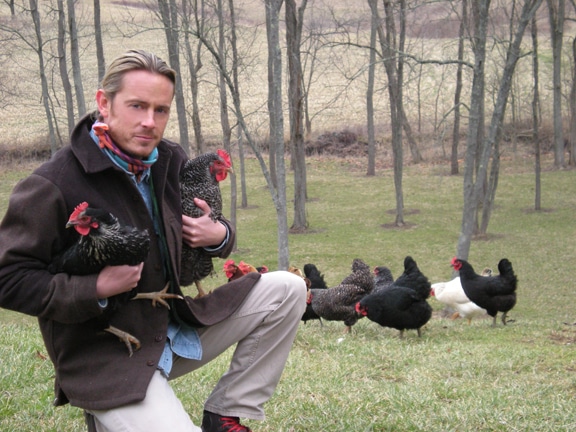
Creek and two of his lovely lady lumps.
I’m a smart man. I have surrounded myself with a very beautiful group of girls who tirelessly landscape my yard, provide rich compost for my garden, dispose of my kitchen scraps, handle insect control around the house, keep me company, and even make me a fresh breakfast each morning. These highly productive females in my life are not actually human. They are chickens, though I affectionately refer to them as my lovely lady lumps.
I consider my small flock of backyard chickens to be one of the best investments I’ve ever made – even though they cost very little time, energy, or money. If you are interested in having a harem of hens in your life like mine, below is some insight about how to get started.
The Perks of Raising Backyard Chickens
Some of you might be wondering – why chickens? Let’s get this question out of the way first. Several years ago, raising chickens was something that only people in the country did. Chickens were associated with farms and wide open spaces. Not anymore! I would actually consider backyard chickens to be a modern cultural phenomenon. Thousands of families are adding a small flock (2-5) to their backyard, right next to the doghouse. When I bought my first house it only had a 20’x20’ backyard. The first thing I did was put in a small chicken coop with three hens, which is the perfect number for starting out. The biggest misconception with raising chickens is that you need to live in the country. This is simply not true. Yes, local regulations or neighborhood ordinances may impact your decision, but many communities are very chicken friendly or easily convinced otherwise.
In my experience, there are many benefits to raising a small backyard flock. Let’s explore some of my favorites.
- Fresh Eggs: Fresh eggs are the most obvious reason, or as I like to call them, “Hen Berries.” Hens will start laying eggs at about 6 months old. They will consistently lay an egg every 1-2 days for several years. These eggs, especially when the chickens are given kitchen scraps and/or allowed to free range, are more flavorful than anything you’ll ever find in the store.

My morning selection of fresh eggs.
- Composting: Chickens are amazing compost factories. They will turn almost any kitchen scrap into a nutrient rich garden additive – poop. They love vegetable scraps, bread, grains, and even meat scraps. We’ll get more into food later.

Chicken-landscaped tree.
- Landscaping and Insect Control: If you allow your chickens to free range (roam out of the coop), they will meticulously landscape around your trees and shrubs. They will also hunt down insects like trained ninja assassins. I often call them my little T-Rexes. I’ve seen them eat every kind of insect you can imagine, as well as snakes, mice, minnows from the shallow edge of our pond, and even a fallen baby bird. They are vicious killers and their distant connected ancestry to majestic birds of prey can be seen when you look into their eye. However, they love fresh grass and plant shoots as well and will happily weed your garden (or planters) once it is established.
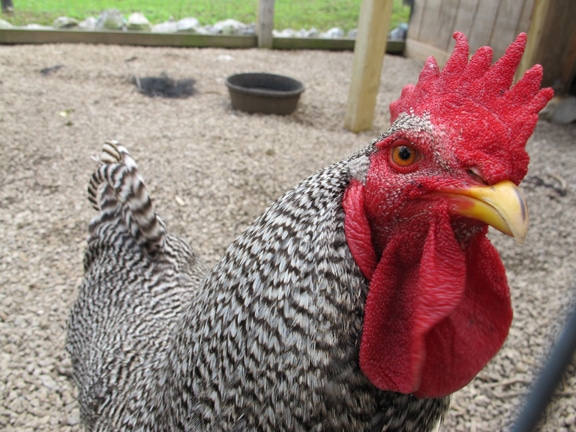
Look into the eye of a merciless killer.
- Pets: Yes, that’s right, chickens make great pets. When you raise and handle chickens from small chicks they will gladly eat from your hand, sit in your lap, and follow you around the yard. They will also happily poop in your lap as well. They’ll come to you when you call and wait for you at the door. They have great personalities. They are incredibly curious and forage for food tirelessly. They rise early and like to go to bed just before dusk. They are absolutely the most low maintenance pet (except for maybe a goldfish) that you can own. As long as they have fresh food, water, and a clean coop, they will be happy as can be. They aren’t needy like many animals and are just as happy when you’re not home. I leave my hens for days at a time with no problems.
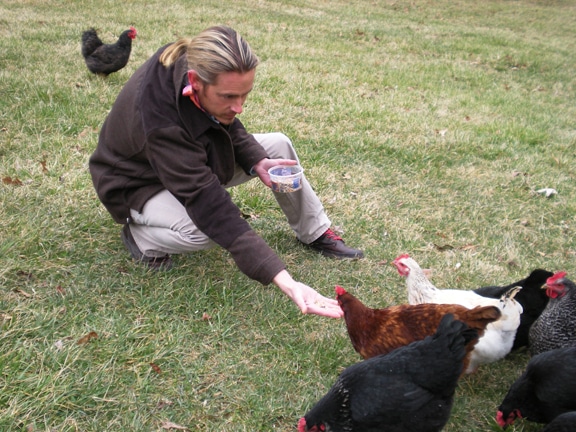
Creek hand-feeding his flock.
- Self-reliance: As a survival instructor at Willow Haven Outdoor, chickens represent a long-term survival strategy. If a time ever comes when food is not so readily available, one can easily scale up a small backyard flock of chickens to help supplement food shortages. As you know, chickens produce eggs, but they also produce chicken. There is something magical about knowing exactly where your food comes from. I know what my chickens eat and therefore know what I’m eating – it’s a simple formula that I quite like.
-
Beauty: It’s easy to take a simple backyard chicken for granted, but many of them have plumage that will rival even the most radiant tropical bird. I’ve owned chickens that were absolutely stunning to look at. The number of chicken breeds to choose from is astounding; from metallic blues and greens to lace-tipped gold feathers, many are truly a natural marvel to behold. I’m often amazed that a bird this beautiful is just walking around in my backyard. Some people raise chickens just for this reason. In fact, there are avid fishermen who raise certain breeds of chickens just to use the feathers for tying high-priced fishing flies.
Raising backyard chickens is simple. As long as you’ve got the basic survival necessities covered you’ll be just fine. Chickens have the same survival needs as we do – shelter, water, and food.
What You Need to Raise Backyard Chickens
Shelter
Some of you may want to raise chickens from small chicks or even hatch your own eggs in an incubator at home. Others may want to skip all of that and buy adult hens already laying eggs. Shelter for baby chickens (chicks) is different from teenagers and adults. I’ll break shelter down into two main categories based upon chicken age.
Shelter for Chickens Less Than Two Months Old
Spring is the best time to get started in raising small chicks. I keep all of my baby chicks inside my home or garage for the first two months. Many farm supply stores carry live baby chicks around Easter, so now is a perfect time to pick up a couple. Unfortunately, it’s difficult to tell girls from boys at this age so you just have to take your chances. Girls (hens) are the only ones that lay eggs, and it takes 4-5 months for baby female chicks to start laying them. Craigslist is also a great place to find chicks (and even laying hens) locally. But, if you want to see something really amazing, order an incubator and fertilized eggs on-line and hatch them yourself. The newborn chicks will make an imprint on you and form a much stronger bond. Backyardchickens.com is a great resource to find both incubators and fertilized eggs.
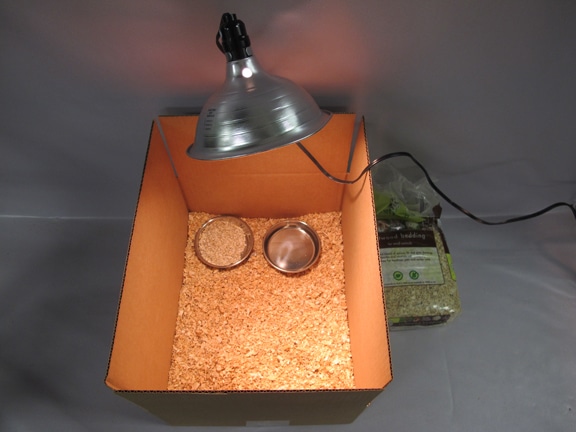
Baby chick cardboard box coop.
I’ve found the best shelter for the first 2 months of raising baby chicks is a good old cardboard box. Regulating temperature is critical for small chicks. This is best done with a heat lamp. Or, you can just use a cheap shop light and standard light bulb. A thermometer in the box will help you adjust the lamp accordingly to regulate temperature. Below are the general temperature ranges for the first several weeks:
Week 1: 95 Degrees Fahrenheit
Week 2: 90 Degrees Fahrenheit
Week 3: 85 Degrees Fahrenheit
Week 4: 80 Degrees Fahrenheit
Week 5: 75 Degrees Fahrenheit
Week 6: 70 Degrees Fahrenheit or room temperature
Week 7: 65 Degrees Fahrenheit or room temperature
Week 8: Room temperature
I’ve found that pine shavings from a local pet store work really well as flooring for your baby chick coop. Chickens are little poop factories so the wood shavings really help with that. I’ve also used newspaper as well. The last two pieces are food and water bowls. Any shallow bowl (no higher than 2 inches) will work just fine. The little chicks need to be able to reach over the rims. You can cut down old butter or whipped cream bowls or buy bowls that suit your needs. You can buy special formulated chick food at farm supply stores called baby chick crumbles or starter ration, but I grew up raising baby chicks on Quaker oats and chopped up vegetable scraps. Chickens grind up the food in their gizzard with little rocks and pieces of sand so it’s important to mix in a little sand with the oats if you go this route. Most of the store-bought feed has this mixed in. The two most important concerns are regulating temperature and keeping a full water bowl. Like humans, these are top survival priorities.
Shelter for Chickens Two Months and Older
Once the chickens reach two months old I move them into my outdoor coop, assuming it’s not the dead of winter. There are literally thousands of different outdoor coop designs. Just do a quick Google search for “chicken coop” and you’ll see what I mean. I normally keep 3-5 chickens in a coop that has a footprint of 4×8 feet. You can buy coop kits on-line or download plans for free. I bought the one in these photos from a guy who makes them and sells them locally on Craigslist. I built my first chicken coop, however, from scrap supplies. I also prefer coops that are mobile, commonly referred to as chicken tractors. These normally have wheels on one side and allow you to move it around the yard so that your hens can free range a bit. When it comes to outdoor chicken coops there are several important details.
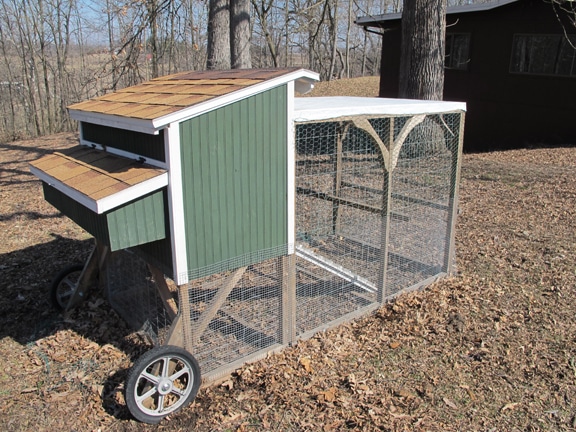
My mobile, 4×8 enclosed chicken coop.
- Security: Security is the #1 purpose of a coop. Chickens, even though merciless birds of prey for anything smaller than a deck of cards, are at the bottom of the food chain and are considered a delicacy by pretty much every predator. In the past, my chickens have been killed by weasels, minks, cats, raccoons, dogs, and even hawks. The term ‘chicken hawk’ takes on a whole new meaning when you’re admiring your hens in the yard from the window and a big hawk comes down and flies off with one dangling from its talons. I’ve concluded that a chicken coop should be wrapped 360 degrees in wire cage. The wire holes should be no larger than 1 inch. There should be no cracks or loose boards where something could slip inside. Where there is a will, there is a way. I’ve seen predators slip through the smallest cracks. All doors should be locking; raccoons are a huge threat and I’ve seen them open simple latches.



